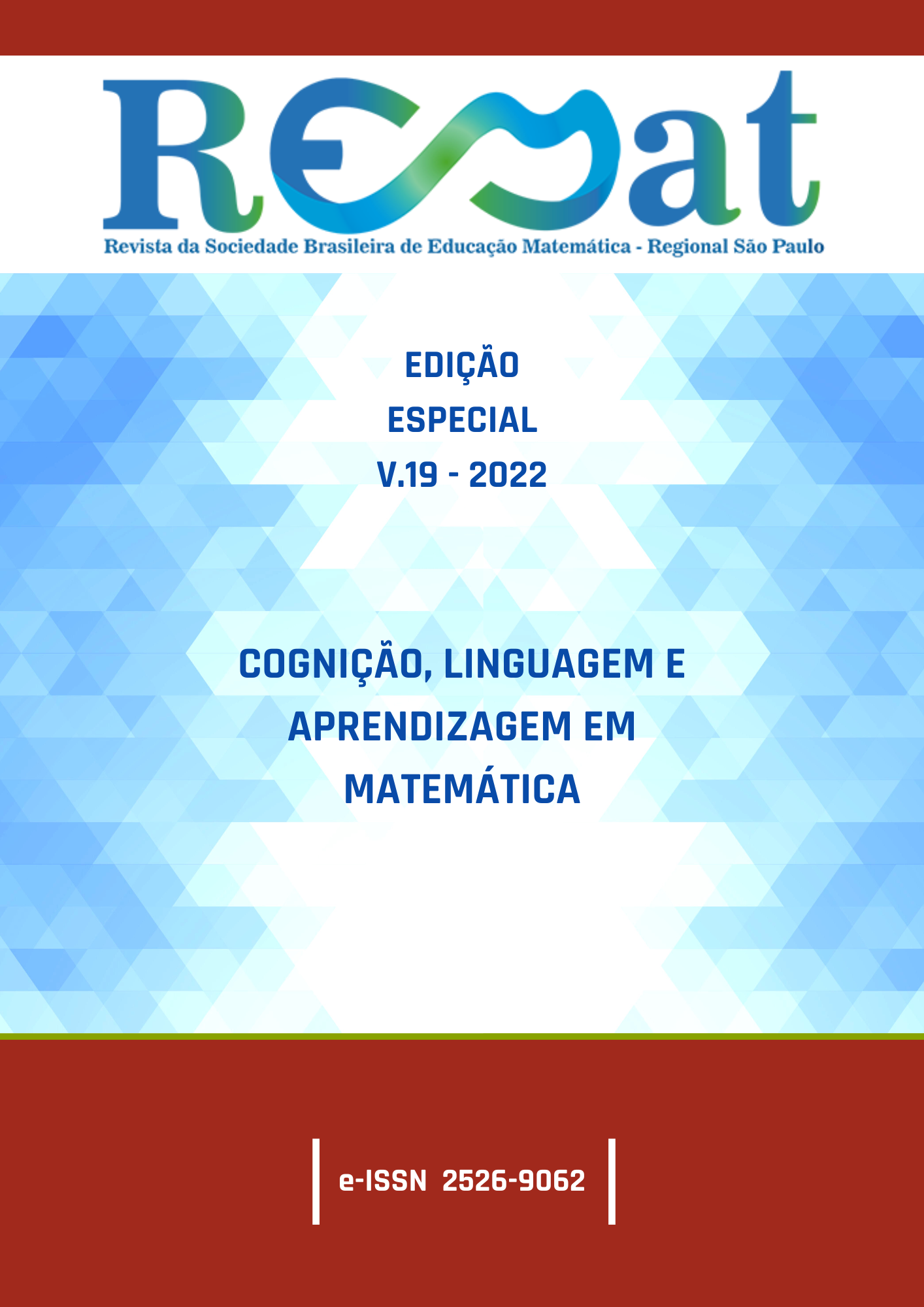Abstraction and image formation in spatial visualization: 3D space and augmented reality
DOI:
10.37001/remat25269062v19id681Keywords:
Geometric thinking, Spatial visualization, 3D GeoGebra CalculatorAbstract
Elements of perception and virtualization constitute the experiment carried out using the augmented reality feature of the GeoGebra Calculator 3D application, with the objective of investigating how activities focused on abstraction and image formation affect the construction of spatial visualization in mathematics undergraduate students. After months of investigation in the research group, a workshop took shape, in order to observe the performance of students in the construction of spatial geometric knowledge, consequently in the formation of mathematical and geometric thinking. The theoretical model of visual-spatial thinking was discussed. Regarding the method, a qualitative and quantitative approach was chosen, with participant observation, content analysis and statistical analysis. The research results demonstrated the expansion of the students' perception when they were submitted to the experiment with a focus on imagery scenario, 3D scenario and scenario with augmented reality. The differences and the expansion of the spatial visualization were significant in the passage from one stage to another, with emphasis on the virtual environment as a facilitator of the process of abstraction and image formation and pattern recognition.
Downloads
Metrics
References
ADLER, Patrícia A.; ADLER, Peter. Observational techniques. In: DENZIN, N. K.; LINCOLN, Y. S. (Eds.). Handbook of qualitative research. California: Sage Publications, 1994. cap. 23, p. 377-392.
AZUMA, Ronald. A Survey of Augmented Reality. Presence: Teleoperators and Virtual Environments, v. 6, p. 355-385, 1997. Disponível em: https://www.cs.unc.edu/~azuma/ARpresence.pdf. Acesso em: 16 out. 2021.
BAIRRAL, Marcelo de Almeida. Tecnologias da Informação e Comunicação na Formação e Educação Matemática. Série InovaComTic, v. 1. Rio de Janeiro: Edur, 2009.
BARDIN, Laurence. Análise de conteúdo. Lisboa: Edições 70, 1977.
BISHOP, Alan. Review of research on visualization in Mathematics Education. Focus on learning problems in Mathematics, Massachusetts: Center for Teaching/ Learning of Mathematics, v. 11, n.1, p.7-16, 1989.
BLANCO, Teresa Fernández; CAJARAVILLE, José Antonio; GODINO, Juan D. Configuraciones epistémicas y cognitivas en tareas de visualización y razonamiento espacial. Investigación en Educación Matemáticas XI, p. 189-197, 2007. Disponível em: https://www.researchgate.net/publication/28231388_Configuraciones_epistemicas_y_cognitivas_en_tareas_de_visualizacion_y_razonamiento_espacial. Acesso em: 03 nov. 2021.
BOGDAN, Robert; BIKLEN, Sari. Investigação qualitativa em educação: uma introdução à teoria e aos métodos. Portugal: Porto Editora, 1994. cap. 1 e 2, p. 48-52.
CARVALHO, Marlene Lima de Oliveira. Representações planas de corpos geométricos tridimensionais: uma proposta de ensino voltada para a codificação e decodificação de desenhos. Dissertação (Mestrado Profissional em Educação matemática). Universidade Federal de OuroPreto. Ouro Preto, 2010.
CHENG, Kun-Hung; TSAI, Chin Chung. Affordances of Augmented Reality in Science Learning: Suggestions for Future Research. Journal of Science Education and Technology, p. 449-462.
COSTA, Maria da Conceição M. Processos mentais associados ao pensamento matemático avançado: visualização. Anais do Encontro da Seção de Educação Matemática da Sociedade Portuguesa de Ciências da Educação. Coimbra: Universidade de Coimbra, 2002.
COSTA, Maria da Conceição M. Modelo do pensamento visual-espacial: transformações geométricas no início da escolaridade. 2005. 314 f. Tese (Doutorado) - Universidade Nova de Lisboa, Lisboa, 2005.
DREYFUS, Tommy. Advanced mathematical thinking processes. In. David Tall. (Org.), Advanced mathematical thinking (pp. 25–41). Dordrecht: Kluwer, 1991.
FIELD, Andy. Descobrindo a Estatística Usando o SPSS. 2ª edição. Porto Alegre: Artmed, 2009.
HCPA. Porto Alegre. v. 32, no. 2, p. 227-234, 2012. Disponível em: https://lume.ufrgs.br/handle/10183/158102. Acesso em: 06 nov. 2021.
HERSHKOWITZ, Rina; PARZYSZ, Bernard; DORMOLEN, Joop Van. Space and Shape. In: A. J. Bishop et al. (Ed.), International handbook of mathematics education (pp. 161- 166). Khover Academic Pubisher, 1996.
JOLY, Maria Cristina Rodrigues Azevedo; MUNER, Luana Comito; SILVA, Diego Vinícius; PRIETO, Gerardo. Visualização espacial e desempenho em matemática no ensino médio e profissional. Avaliação Psicológica, 2011, 10(2), p. 181-191. Disponível em: https://www.researchgate.net/publication/317463344_Visualizacao_espacial_e_desempenho_em_matematica_no_ensino_medio_e_profissional/citations. Acesso em: 16 out. 2021.
KNECHTEL, Maria do Rosário. Metodologia da pesquisa em educação: uma abordagem teórico-prática dialogada. Curitiba: Intersaberes, 2014. Disponível em: https://www.redalyc.org/pdf/894/89442687013.pdf. Acesso em: 03 nov. 2021.
LEOTTI, Vanessa Bielefeldt; COSTER, Rodrigo; RIBOLDI, João. Normalidade de variáveis: métodos de verificação e comparação de alguns testes não-paramétricos por simulação. Revista
MEKNI, Mehdi; LEMIEUX, André. Augmented Reality: Applications, Challenges and Future Trends. Applied Computational Science. 2014, p. 205-214. Disponível em: http://www.cs.ucf.edu/courses/cap6121/spr2020/readings/Mekni2014.pdf. Acesso em 04 nov. 2021.
PARZYSZ, Bernard. “Knowing” vs “seeing”. Problems of the plane representation of space geometry figures. Educational Studies in Mathematics, Netherlands, v.19, n. 1, p. 79 - 92, fev. 1988.
PRESMEG, Norma. Research on Visualization in Learning and Teaching Mathematics. In Gutierrez, A & Boero, P (eds). Handbook of Research on the Psychology of Mathematics Education: Past, Present and Future, pp. 205-235. The Netherlands, Sense Publishers, 2006.
RESENDE, Bruno; MULLER, Thaísa Jacintho. Mobile-learning: aprendizagem matemática por meio de realidade aumentada. Revista de Educação, Ciência e Tecnologia, Canoas, v. 7, n. 2, 2018. DOI: 10.35819/tear.v7.n2.a3187. Disponível em: https://periodicos.ifrs.edu.br/index.php/tear/article/view/3187. Acesso em 29 out. 2021
SETTIMY, Thaís Fernanda de Oliveira; BARRAL, Marcelo Almeida. Dificuldades envolvendo a visualização em geometria espacial. VIDYA, v. 40, n. 1, p. 177-195, jan./jun., 2020 - Santa Maria, 2020. ISSN 2176-4603. Disponível em: https://www.researchgate.net/publication/343556166_DIFICULDADES_ENVOLVENDO_A_VISUALIZACAO_EM_GEOMETRIA_ESPACIAL. Acesso em: 04 nov. 2021.
TORI, Romero; HOUNSELL, Marcelo da Silva; KIRNER, Claudio. Realidade Virtual. In: TORI, Romero; HOUNSELL, Marcelo da Silva (org.). Introdução a Realidade Virtual e Aumentada. Porto Alegre: Editora Sbc, 2018. Cap. 1. p. 13-35. Disponível em: http://www.de.ufpb.br/~labteve/publi/2018_livroRVA.pdf. Acesso em: 08 nov. 2021.
ZIMMERMANN, Walter; CUNNINGHAM, Steve. (Eds). Visualization in Teaching and Learning Mathematics: a project. Washington, D.C. : Mathematical Association of America, 1991.
Downloads
Published
Métricas
Visualizações do artigo: 457 PDF (Português (Brasil)) downloads: 205
How to Cite
Issue
Section
License

This work is licensed under a Creative Commons Attribution-NonCommercial-NoDerivatives 4.0 International License.


 Português (Brasil)
Português (Brasil)
 Español (España)
Español (España)
 English
English






































